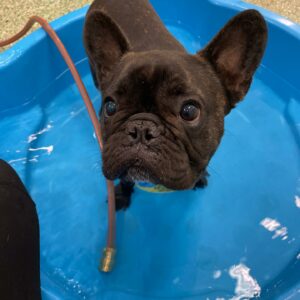Swimming is wonderful exercise for dogs, just like it is for humans, and it can help keep them in shape when they’re older and arthritis sets in. But whether your dog will take like a duck to water depends partly on its breed. Dogs with large chests and small hindquarters such as Bulldogs, or with short legs like Dachshunds, aren’t designed for swimming and may not stay afloat.
Even breeds like Labrador Retrievers who are traditionally great swimmers can’t necessarily be expected to be absolute naturals. An otter cub hesitates and has to be persuaded into the water the first time. So never throw your dog into water with the misguided idea that it will ‘sink or swim’ (that is, in this case, hopefully swim) because you could put it off water for a long time or even give it a phobia for life.
Ideally your dog will be young – some say the younger the better – because puppies are more adaptable. The site you choose for your puppy’s introduction to swimming should have the following characteristics:
- The water should be clean and unpolluted
- There should be no intrinsic hazards like fast currents, nearby waterfalls or submerged man-made objects
- The bottom should not be choked with weeds as these can trap and drown a dog
- You should feel confident about being allowed to use the site because any anxiety on your part will communicate itself to your dog
- You should feel happy to paddle or wade alongside your dog – no slippery mud or freezing water temperatures
The first thing is to allow your puppy to run in and out of water. If you’ve chosen a beach, lake shore or a pond, there mustn’t be any sudden drop into the water. If you’re using a paddling pool or swimming pool, make sure your puppy can get out of its own volition, by jumping over the sides of the paddling pool or climbing up the inside steps of a swimming pool. Not only will your pooch feel more in control, but it won’t be scrambling at the liner or piercing inflatable sides with its claws.
After your puppy has shown it enjoys the new element, carry it gently into water deep enough for it not to be able to touch the bottom. Hold it in the water with both hands under its belly and allow it to make paddling movements with its legs. The movements are instinctive: dogs ‘run’ in the water like they do on land – they don’t in fact do the stroke we call dog-paddle (which would be the equivalent of trotting).
When the paddling movements are strong, remove one hand altogether and put the other under the back end of your dog to ensure that part remains level with the head and doesn’t sink down. Staying level in the water is one of the challenges of swimming for puppies and children alike, and if the correct position is ‘felt’ from the outset then drifting towards the vertical may never be a problem.
If you can, swim alongside your puppy. Make sure it knows the way out of the water, for example where the bottom shelves to the shallows, but always be there to help it onto dry land. Swimming should be an enjoyable experience for a puppy so give it lots of verbal praise at the outset and pamper it with a towel-dry and a warm hug particularly if the water is cold. Watch out for it shaking itself, though!